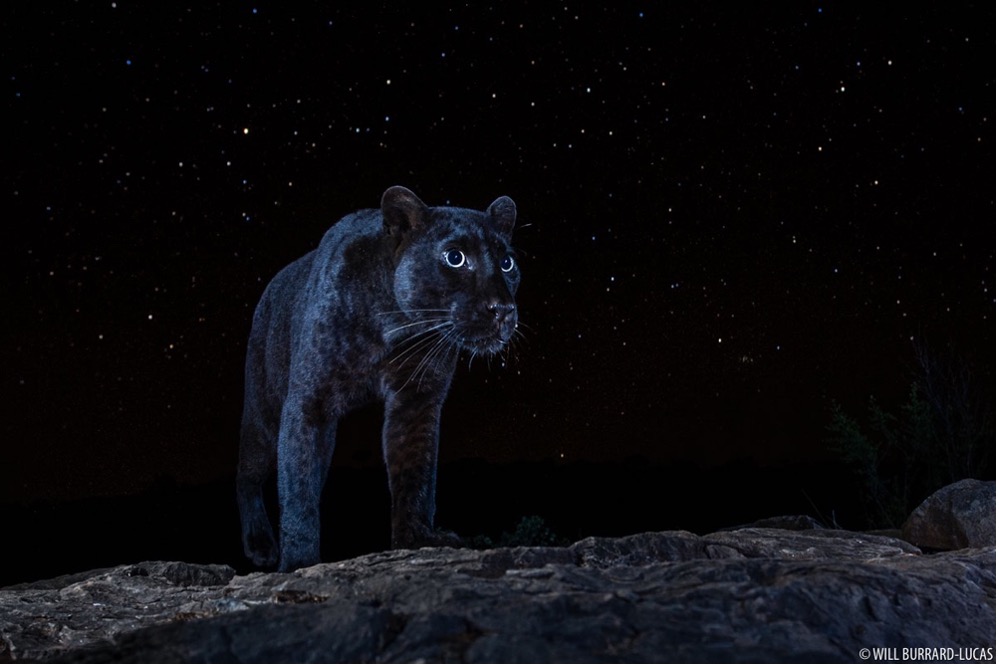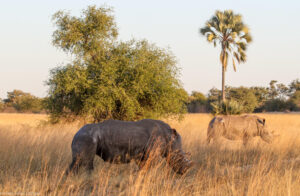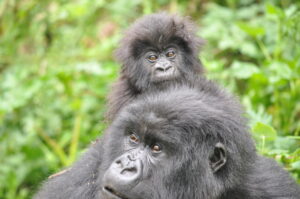
For more than a century, the only known documented proof of an African melanistic leopard was a 1909 photograph taken in Ethiopia, stored in Washington DC’s National Museum of Natural History.
But in 2017, a leopard conservation research programme led by Dr Nicholas Pilfold of the San Diego Zoo Wildlife Alliance heard of a black leopard on Laikipia‘s Lorrok ranch. Remote camera traps were set up, and between February and April 2018, a lone subadult melanistic female was snapped at five separate locations.
Melanistic leopards owe their distinctive appearance to a recessive gene that causes excessive pigmentation in the skin and hair, resulting in seemingly pitch-black coats. However, up close or in certain lights, the leopard’s classic rosette markings can still be spotted (no pun intended). For a cub to be born black, both its parents must carry the gene, but while a pair of black leopards will always have black cubs, interestingly, “golden” spotted leopards can carry the gene silently. So, even a pair of spotted leopards (provided both carry the gene) can produce melanistic offspring.
It takes luck and skill for a black leopard to survive to adulthood on the African plains. Their high visibility (even in moonlight) leaves them vulnerable as cubs and makes hunting tricky for most of the month. So, although 11% of today’s leopards are melanistic, most are found in Southeast Asia’s tropical forests, where the dense jungle provides the perfect camouflaged hunting ground.
Pilfold’s teams’ rudimentary shots provided the proof the wildlife community had been waiting for. But they didn’t capture the leopard’s sheer magnificence. For that, look to award-winning wildlife photographer Will Burrard-Lucas. Renowned for his innovative night photography and remote camera work, Will headed to Laikipia on a recce in 2019. Supported by the local community, including Laikipia Wilderness Camp‘s owners, Steve and Annabel Carey; their neighbour, Luisa Ancilotto; and leopard researcher, Letoluai Ambrose, Will deployed a series of high-tech remote camera traps across the area.
“Luisa had recently seen a young black male leopard, but it was a race against time to photograph it before it was pushed out by an older male,” Will recalled. “I wasn’t expecting anything…so, when I captured that first image on my initial trip, it was a real ‘pinch me’ moment.”
With the first high-quality camera trap photograph of a wild African melanistic leopard in the bag, Will became set on capturing the leopard “against a sky filled with stars”. But for that to happen, he needed a moonlight-free clear sky – and the right leopard (he got some stunning shots of a spotted male!) facing the right way.
“The spotted male’s presence was causing the black leopard to roam further away. Months could go by with no show, and I began to doubt I’d get the shot before he disappeared completely.”
But finally, six months into the project came the ultimate shot Will had been dreaming of:

You can find out more about Will’s year-long quest and his subsequent book, The Black Leopard, here. Fortunately for those of you with less spare time, the chance of snapping a Laikipian black leopard has got easier: a black female known as Giza was born during the pandemic and has grown up close to Laikipia Wilderness Camp. Far more habituated than Will’s male, Giza is seen regularly—almost six nights a week—and has been spotted by several Expert Africa guests and our East Africa Manager, Richard Trillo.
“I was lucky enough to spend an hour one evening tracking her as she hunted dik-dik (only to have her prey stolen by a canny spotted male leopard). The challenge and the pleasure of being there will stay with me for a long time.” – Richard Trillo
It’s thought as many as eight black leopards patrol the surrounding area, with another melanistic female seen relatively frequently. Meanwhile, camera trap footage suggests several more inhabit the broader landscape, with territories including Ol Doinyo Lemboro and the neighbouring Loisaba Conservancy.
If you’ve been inspired and want to find out more, give us a call or enquire now to speak to an expert.
*A version of this article originally appeared in the April 2024 Bush Telegraph newsletter. You can read our recent newsletters and sign-up to receive these in your inbox on our Bush Telegraph newsletter page.





